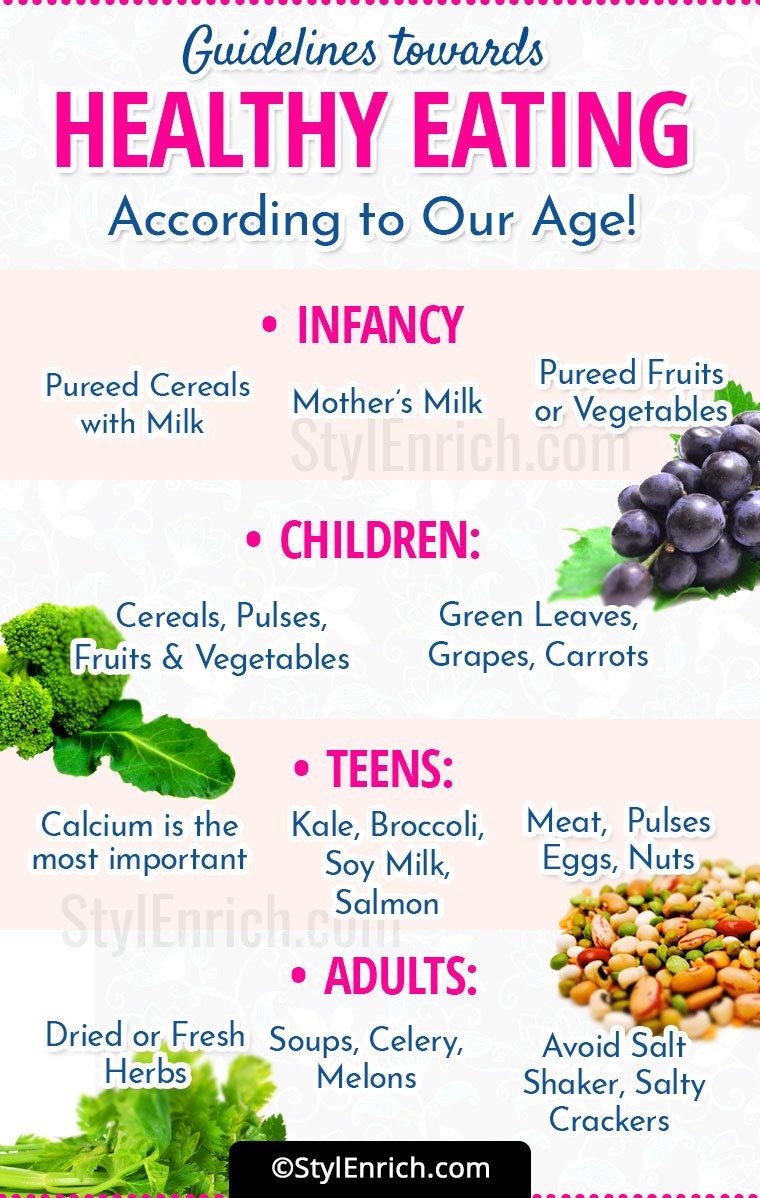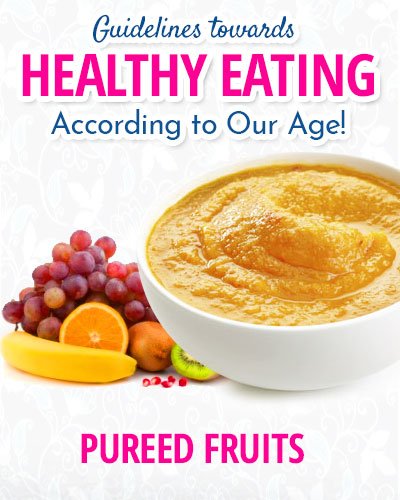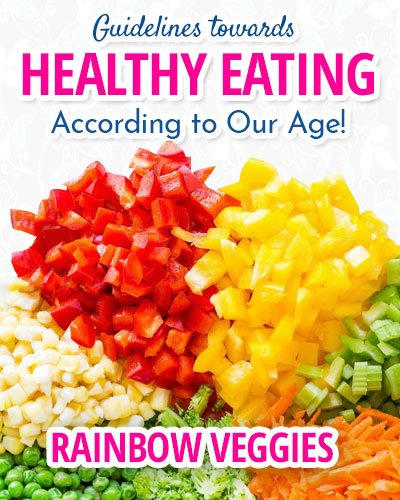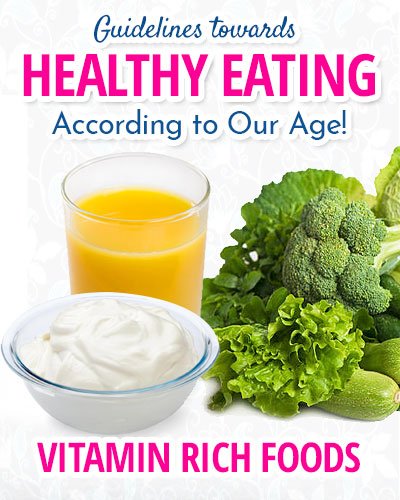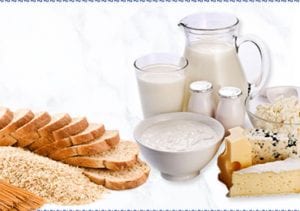- With advancing age, there are changes in body and our nutritional needs also change accordingly.
- Though the concept of the balanced diet is constant for the whole life cycle, minute details of what nutrients to eat and what can be reduced for each age group make our living healthy and positive.
- A professional help in choosing the food and going through the diet pattern effectively can make a commendable difference in our life.
Age is not just a number. With increasing age, we tend to experience bodily changes and milestones that are specific to that particular age. According to our age, nutrition priorities also change with our changing bodily needs and requirements. We have been told from childhood that balanced diet and proper physical activity is always the essence of a healthy living. We should always work towards having smaller and healthier portion size divided about 6 times a day and inclusion of all nutrients in correct balance. Hence though the principle of healthy eating is the same for any age, there can be few modifications with respect to the age so that we can pass through the phase positively and actively.
Nutritional Guidelines
Every age represents the important milestone that will be achieved well with proper nutrition and diet. Hence, according to every age, the nutritional guidelines are as follows:
1. Infancy
The first year of life, infancy is the most important point of growth and developmental changes in the body. Whatever infants eat during the initial stage is the turning point for body weight, health and aging in the long-term phase. Hence nutrition at an optimum level is essential for overall growth, health and development. For the first six months, exclusive breastfeeding is mandatory for the well-being of the infant as mother’s milk contains the right proportion of nutrients like protein, fat, carbohydrates and cholesterol and also provides protection against various diseases for the babies.
Once the babies grow beyond six months of age, solid foods can be introduced slowly starting with pureed cereals with milk and then later pureed fruits or vegetables. Introduce single food at a time for the babies to adjust and plan to feed the baby frequently throughout the day so that they get a continuous supply of calories, protein and iron to keep them active. Salt, sugar or artificial sweeteners may not be added and soft foods are given to infants so that the food is easy to digest. Once they develop teeth, then solid foods can be introduced but the texture needs to be soft. Make sure that the foods are nutritionally adequate and safe and do not replace breastfeeding which can be continued up to 2 years of age.
2. Children
Childhood is the time when behavior and habits are being set where there are rapid growth and development. We always suggest that kids should have a healthy diet, consisting of cereals, pulses, fruits and vegetables but it is always a task to make kids eat their meals much to the chagrin of the mothers. Small children require about 2 servings of fruits and 3 servings of vegetables a day. Encourage them to choose among the rainbow colors in vegetables like green leaves, purple grapes, orange carrots, yellow capsicum and red tomatoes. Going to school, doing extracurricular activities, going for extra classes, playing and studying, kids are always in full vigor and vitality. Hence to fulfill the increasing body demands which include growth and development, the diet of good nutritional quality like the high quality of protein, wholesome foods, umpteen supply of fruits and vegetable help in matching the nutritional needs.
The caloric requirements for kids of age 2 years having weight about 12 kgs range from 1240 calories to 2190 calories in boys of age 10 to 12 years weighing up to 35 kgs and 1970 calories in girls of age 10 to 12 years weighing up to 31kgs.
Kids need to be habituated to eating healthy from the young days itself. There are many avenues where kids do get tempted to buy packaged convenience foods or junk foods. Occasionally having these foods is fine but it should not be a regular affair. Always pack a fruit like a banana or an apple or an orange into their lunch boxes or even vegetables like carrot or cucumber sticks or tomato slices to inculcate the habit of having fresh and raw foods every day.
3. Teens
The dietary principle for boys and girls may be the same but still as they pass through the teenage years; requirements start to differ a little for boys and girls.Teenage years are the period of rapid growth and development and the demand for nutrients are the maximum. However, with the rise of globalization, an inclination of teenagers towards saturated fats, added sugars and high salt and fat-containing foods are the maxima. Hence obesity and overweight are the common occurrences in teenagers. Even eating disorders like anorexia have been seen the maximum in teenagers, especially the girls. Teenagers tend to try unsuitable methods of reducing weight like smoking, skipping meals or avoiding fattening foods thus resulting in the exclusion of whole food group and nutritional deficiencies. Kids with weight issues can always take the help of professionals for conscious selection of food and improve the dietary pattern.
Calcium is the most important nutrient for bone development and growth in teens. Teenagers require about 1,300 mg of Calcium per day and milk, being the good source of calcium provides about 300 mg of calcium from one glass. Even milk products like yogurt and cheese supply daily dose of calcium. Those who don’t like milk can always have an option of having kale, broccoli, calcium-fortified soy milk, tofu or salmon. Teens require a good supply of protein in order to maintain growth and improve the muscle mass and boost immunity. Teens require about 5 to 6 ounces of protein a day that can be supplied by protein-rich foods like meat, poultry, eggs, nuts, legumes and pulses. Teens need to limit fat intake to 25 to 35 percent. Peer pressure, improved standard of living and easy feasibility contributes to teens to prefer more of junks that are high in fat and sugar. Hence the conscious choice of food containing healthy fats is necessary. Prefer olive oil or canola oil, if you need to add oils. Have more of avocados, fishes, almonds or flaxseeds that are containing healthy fats.
4. Adults
Adults experience a number of changes in life like moving out for work, getting married, staying away from home and changing lifestyle can affect the nutritional choices thus bringing out the dietary changes. It is in this phase of life that women go through pregnancy, lactation and menopause thus affecting the food choices. The growth comes to a halt in this phase thus the need for nutrients in adults are lesser as compared to children or teens. However, if not taken care during this stage, a number of lifestyle disorders like cardiovascular issues, diabetes, and metabolic syndrome develop later. Hence it is essential that physical activity and diet needs to be taken care of. Anything in excess can cause serious problems.
The nutritional requirements of adults do not change much from 19 to 50 years, except during pregnancy and lactation. However, their needs change according to the gender and the level of activity.Research suggests that overweight and obesity occurs in the majority of individuals when the calorie intake goes about 30 % more than the recommended intake in women (1875 calories) and men (2125 calories). Apart from this, faulty snacking, wrong food choices and the minimum level of activity can affect the health. In spite of having more than required nutrients, the intake of certain vitamins and minerals are less in same age or sex. E.g.: intake of iron and calcium are less in younger women. Limit the fat intake to less than 25% of the calories consumed with saturated fats about less than 10% of the daily calories. Limit your fat intake to preferring monounsaturated or polyunsaturated fats and limit the cholesterol level to less than 300 mg. Limit the sodium intake to 2,300 mg per day. Avoid salt shakers, salty crackers or adding top salt in food. Prefer dried or fresh herbs and garlic instead of salt. Drink ample amount of water, about 8 to 10 glasses a day. Apart from having water just when you are thirsty or with the meal, have water or any form of liquids separately like having soups, celery, melons, juices or other beverages.
5. Older Adults
In elderly individuals, the basal metabolism and lean body mass reduce as a result of which the requirements of energy per kg body weight of elders are less. When the requirement of certain nutrients is less at this stage, the need for certain essential nutrients is more. Many of the disorders suffered by the elders are basically due to dietary factors that have been observed since long from childhood or young adults.
With every decade, the nutritional needs also decline. With age, you move around less, you have less lean mass and the metabolic rate goes down. The caloric intake for an elderly female is 1600 calories and for an elderly male is 1800 calories. About 45 to 65% of daily calories should come from carbohydrates, especially complex carbohydrates like sweet potatoes, legumes, and brown rice. It is necessary to have fiber every day, about 30 gms a day for males and 21 gms a day for females. Protein needs can come up to 46 to 56 gms a day and less than 20% of calories from fat. If they have issues with kidney function, they need to consult the doctor about the protein needs. Limit the sodium intake to 1500 mg per day and improve the potassium needs to 4700 mg per day by having fresh fruits and vegetables, milk and milk products. Adults above 75 years should get about 2.4 micrograms of Vitamin B12 per day by having supplements or fortified cereals. They should also have 20 micrograms of Vitamin D and 1200 mg of Calcium per day. They can have leafy vegetables, Vitamin D fortified milk, yogurt and fruit juice.
Hence with every age group, the changes in the body and metabolism direct us to modify the nutritional needs to meet the requirement of that particular age. Though the basic nutrition choice may be the same for every age, the need for nutrient keeps on changing with every phase of life. If there is any confusion regarding the food needs of different age then you can always take the help of the dietician.
Frequently Asked Questions
1. Can you please suggest a ready reckoner type of table about how much calories and protein should be consumed at various ages?
Yes. The number of calories and protein consumed for various ages is as follows:
1) Man (sedentary work) 60 kg ———- 2425 kcals——-60 g Protein
2) Woman (sedentary work) 50 kg———1875 kcals——-50 g Protein
3) Pregnant woman 50kg———————-+300 kcals——+15 g Protein
4) Lactation
0 to 6 months 50 kg————————-+550 kcals——–+25g Protein
6 to 12 months 50kg————————+400 kcals———-+18 g Protein
5) Infants
0 to 6 months 5.4 kg—————————–108/kg—————2.05/kg
6 to 12 months 8.6 kg—————————-98/kg—————–1.65/kg
6) Children
1 to 3 years 12.2 kg————————1240 kcals————–22gProtein
4 to6 years 19.0 kg————————-1690 kcals————-30 g Protein
7 to 9 years 26.9 kg————————–1950 kcals————41g Protein
7) 10 to 12 years
Boys 35.4 kg————————2190 Kcals————–54 g Protein
Girls 31.5 kg————————1970 kcals—————-57 g Protein
8) 13 to 15 years
Boys 47.8 kg——————–2450 kcals—————–70 g Protein
Girls 46.7 kg——————-2060 kcals—————–65 g Protein
9) 16 to 18 years
Boys 57.1 kg————————2640 kcals————–78 g Protein
Girls 49.9 kg———————–2060 kcals—————63 g Protein
2. We know that balanced diet is very much essential for better health. But we tend to go out frequently and end up eating junk foods. Not only the kids, even we elders tend to gorge on high fat and high sugar foods. Is there any suggestion how to tackle this keeping health in mind?
Yes, sometimes it is not possible to eat as we plan. But even while eating out, you can be smart enough to choose foods and prefer the healthier options. If we are planning to eat out, you can have a healthy snack like unsweetened yogurt or two tablespoons of nuts or a small bowl of fresh fruit cuts at home first and then leave for the restaurant. In this way, you will not gorge on the food in the restaurant.Even in the restaurant also, you can take the liberty of asking the waiter about how the dish is prepared or what ingredients have been added. If the restaurant is willing to cater to your needs, you can prefer healthy cooking options for foods like prefer grilling rather than frying, prefer boiled forms rather than creamy or cheesy forms or even baked carrot sticks or zucchini sticks with simple dips rather than potato chips or French fries. You can always order salads with minimum dressing like vinegar dressing or lemon juice dressing before the main course.
Read on –Top 7 Shocking Nutrition And Food Facts!
